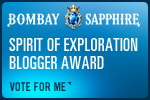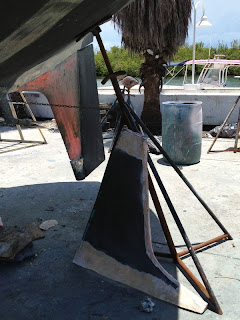Roberto got right to work the next morning, Friday, arriving at the boatyard with a milk crate full of tools. Nan and I were waiting there to give him the second 1,000 pesos he had requested as a deposit. He thanked us and pulled out his rotary sander. We told him we would return later to see how it was going and pedaled away on our folding bikes.
When we returned, Roberto was at the entrance gate signing out with the security guard. He walked with us back to the boat and showed us how he had cleaned up all the ragged edges on the skeg shells and on the skeg itself. He told us he would be back on Saturday to begin the fiberglassing.
The photos show the progression of Roberto's fiberglass work on the skeg over the next few days. While we were at it, we also contracted with him to repair and paint the scars left by the removal of our old Aries windvane, as well as numerous hull scratches from past docking mishaps, for an additional 3,000 pesos.
This extra work required a trip over to Cancun the following Monday to visit a few different marine paint stores, but first we met Nazario at Nauticos Cancun, a marine supply store, to buy new zincs for the hull and propeller shaft. While we were
there, I noticed that a gallon of Pettit bottom paint was priced at 4,350 pesos. I did the conversion, and it worked out to $362.00! Nazario said it was so expensive because it was so heavy to ship from the United States. (A gallon of water weighs a little over eight pounds, but a gallon of bottom paint weighs at least twice that because of all the growth-inhibiting metals it contains.) We had worked out the details with the boatyard to have them paint the bottom after Roberto finished, but I didn't expect the necessary three gallons to cost over a thousand dollars. Nazario suggested that we use Mexican bottom paint instead and drove us over to Nervion Pinturas, which seemed an appropriate name as the fumes inside the store were enough to cause nerve damage.
We took three gallons of black Nervion bottom paint to the counter, along with three liters of solvent. Then Nazario went back and forth with the paint-mixing man in rapid Spanish to see about getting quarter-liters of touch-up paint, matched as closely as possible to the Awl Grip paint sample sheet I had brought along. Whispering Jesse's "Snow White" and "Royal Blue" were not easy matches, and it took several minutes for the man to mix close colors. Nan and I were getting headaches from the paint fumes by then and wondering why the large ventilation hood above the counter was not running at full blast.
With a trunk full of very heavy paint, Nazario drove us to the ferry dock for the ride back to Isla Mujeres. We thanked him profusely for his help and offered him money to at least pay for his gas, but he would not take it. He is a very good man and we appreciate him tremendously.
This blog is an account of the pursuit of a dream, to sail around the world. It is named after the sailboat that will fulfill that dream one day, Whispering Jesse. If you share the dream, please join me and we'll take the journey together.
For Charlie and Scout
For Charlie and Scout
About Me

- John Lichty
- Savannah,
Georgia, USA
"Go confidently in the direction of your dreams. Live the life you have imagined." --Henry David Thoreau
 Raising Charlie: The Lessons of a Perfect Dog by John Lichty
Raising Charlie: The Lessons of a Perfect Dog by John Lichty
Blog Archive
Followers

Recommended Links
- ATN Sailing Equipment
- ActiveCaptain
- BoatU.S.
- Coconut Grove Sailing Club
- Doyle Sails - Fort Lauderdale
- El Milagro Marina
- John Kretschmer Sailing
- John Vigor's Blog
- Leap Notes
- Noonsite.com
- Notes From Paradise
- Pam Wall, Cruising Consultant
- Practical Sailor
- Project Bluesphere
- Sail Makai
- So Many Beaches
- Windfinder
Sunday, July 21, 2013
Subscribe to:
Post Comments (Atom)









2 comments:
It's always great when you find good skilled people to help you and do good work. You are lucky to find him. Glad everything worked out so well for you guys! Dave Q and Karen K
We would be nowhere without the help of our friends here on Isla Mujeres. We are lucky to know them. Nan and I hope to see you two here again next time. Take care!
Post a Comment